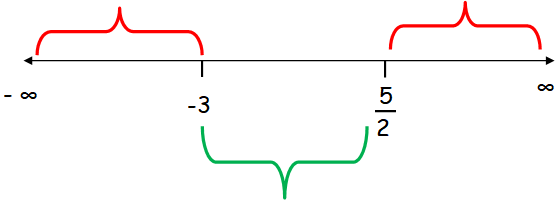HOW TO SOLVE QUADRATIC INEQUALITIES STEP BY STEP
In this section, you will learn, how to solve quadratic inequalities in the form
ax2 + bx + c < 0
ax2 + bx + c ≤ 0
ax2 + bx + c > 0
ax2 + bx + c ≥ 0
(i) First solve ax2 + bx + c = 0.
(ii) If there are no real solutions, then one of the above inequality holds for all x ∈ R
(iii) If there are real solutions, which are called critical points, then label those points on the number line.
(iv) Note that these critical points divide the number line into disjoint intervals. (It is possible that there may be only one critical point.)
(v) Choose one representative number from each interval.
(vi) Substitute that these representative numbers in the inequality.
(vii) Identify the intervals where the inequality is satisfied.
Example 1 :
Solve 2x2 + x − 15 ≤ 0.
Solution :
First let us solve the given quadratic equation by factoring.
2x2 + x − 15 = 0
2x2 + 6x - 5x − 15 = 0
2x(x + 3) - 5(x + 3) = 0
(2x - 5) (x + 3) = 0
2x - 5 = 0 x + 3 = 0
2x = 5 x = -3
x = 5/2
The critical numbers are -3 and 5/2.
Now let us mark them in number line.

Applying any values within the interval, we get
|
Intervals |
Signs of factors (2x-5)(x+3) |
Sign of given inequality |
|
(-∞, -3] say x = - 4 |
(-) (-) |
+ |
|
[-3, 5/2] say x = 0 |
(-) (+) |
- |
|
[5/2, ∞) say x = 3 |
(+) (+) |
+ |
From the above table, we come to know that the interval [-3, 5/2] satisfies the given inequality.
Hence, the solution is [-3, 5/2].
Example 2 :
Solve −x2 + 3x − 2 ≥ 0.
Solution :
First let us solve the given quadratic equation by factoring.
The coefficient of x must be positive, so we have to multiply the inequality by negative.
x2 - 3x + 2 ≤ 0
Multiply the equation by negative.
x2 - 3x + 2 = 0
x2 - 1x - 2x + 2 = 0
x (x - 1) - 2(x - 1) = 0
(x - 2) (x - 1) = 0
x - 2 = 0 x - 1 = 0
x = 2 x = 1
Writing them as intervals, we get
(-∞, 1] [1, 2] [2, ∞)
Applying any values within the interval, we get
|
Intervals |
Signs of factors (x-2)(x-1) |
Sign of given inequality |
|
(-∞, 1] say x = 0 |
(-) (-) |
+ |
|
[1, 2] say x = 1.5 |
(-) (+) |
- |
|
[2, ∞) say x = 3 |
(+) (+) |
+ |
From the above table, we come to know that the interval [1, 2] satisfies the given inequality.
Hence, the solution is [1, 2].
Kindly mail your feedback to v4formath@gmail.com
We always appreciate your feedback.
©All rights reserved. onlinemath4all.com
Recent Articles
-
Trigonometry Pythagorean Identities
May 02, 24 11:43 PM
Trigonometry Pythagorean Identities -
Trigonometry Quotient Identities
May 02, 24 11:08 PM
Trigonometry Quotient Identities -
Unit Rates
May 02, 24 09:27 AM
Unit Rates - Concept - Examples with step by step explanation